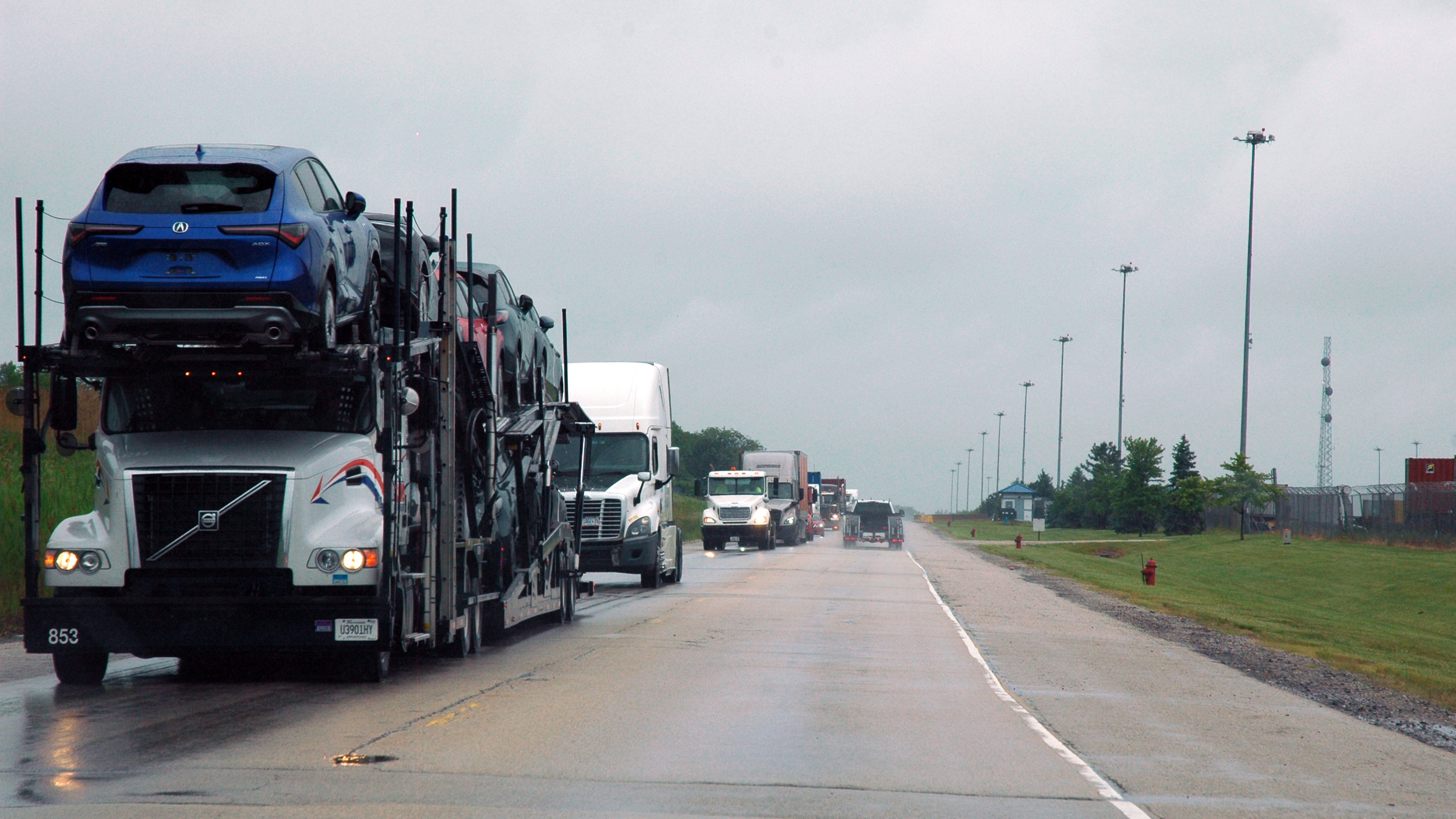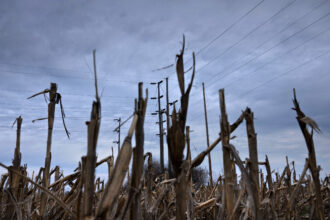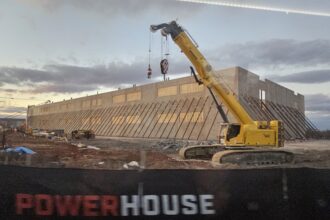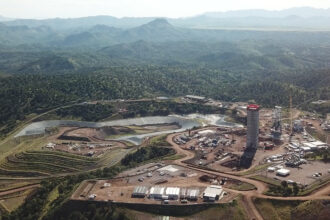ELWOOD, Ill.—When Terri Papesh says she can’t stand the smell of diesel, she doesn’t mean it figuratively. The 62-year-old has a variety of health problems that make her more sensitive to the sulfur dioxide molecules spewing from the tailpipes of semi-trucks. “I have literally had times where diesel fumes would send me into an asthma attack,” she said.
The problem is that she lives a few miles from North America’s largest inland intermodal transport hub, where trucks are constantly in and out to pick up and drop off goods moving around the country. And now that traffic is poised to grow in a big way.
NorthPoint Development is building a warehouse project on 4,000 acres not far from the existing 6,400-acre CenterPoint Intermodal Center in Will County. An analysis for the developer estimated that it would bring 1,300 new truck trips daily, and opponents think that will prove to be a huge undercount. Not everyone would risk immediate health effects like Papesh, but the brew of air pollutants from that level of truck traffic includes carcinogens, key ingredients for forming lung- and heart-damaging smog and tiny, toxic-studded particles that contribute to early death.
The last five years have seen a boom in warehouses across the country, not just in number but also in size. Some are in dense urban areas, but others are located in more rural places convenient to population centers. The NorthPoint site, for instance, is on the edge of the Chicago metro area, about 40 miles southwest of the city.
The developer recently cleared a final hurdle for the project by resolving a dispute with CenterPoint over road access. A small portion of the planned warehouses have already been built.
The city of Joliet, which overlaps with part of the NorthPoint development, approved the project plan. The nearby villages of Elwood and Manhattan have been vocal about their opposition. Both are involved in pending lawsuits over the development, but meanwhile, the construction is set to continue.
Some 3.5 percent of the nation’s gross domestic product moves through Will County, County Executive Jennifer Bertino-Tarrant said last year, and the truck traffic from existing warehousing is already substantial.
“This whole area has just changed so dramatically,” said Stephanie Irvine, 41, who lived in Will County for almost all her life and can smell—in addition to seeing—the difference. “Even in the last decade, with the amount of traffic that you see, just the whole landscape has changed.”
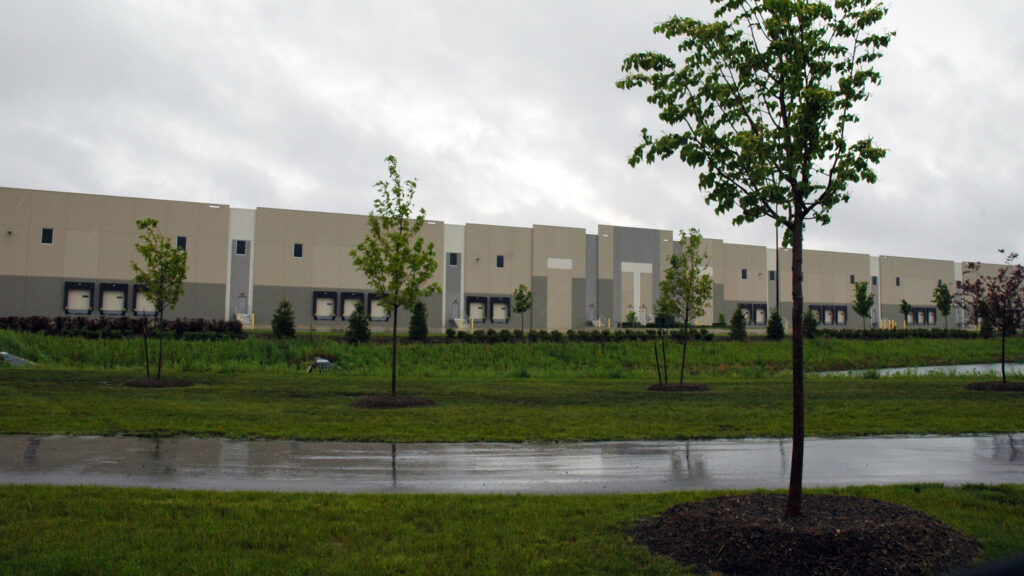
Now, she owns property near the village of Manhattan that would abut the NorthPoint complex if the company completes its full buildout.
She’s among the residents who formed groups to oppose the project. Those groups, Just Say No to NorthPoint and Stop NorthPoint, both have sued to try to stop the development.
NorthPoint did not respond to multiple requests for comment.
In Joliet, the city that approved the project, officials welcomed the increased tax revenue and jobs they expect to see.
“NorthPoint aimed to leverage Joliet’s strategic location to expand on the city’s existing
transportation, distribution, and logistics infrastructure,” the Joliet city manager’s office said in a statement. “While the project was approved by the previous administration, the current administration is fully aware of [community] concerns and is actively working to mitigate potential negative impacts, including pollution and traffic.”
From Munitions to Megawarehouses
Where CenterPoint and part of the NorthPoint project stand today was once a military complex manufacturing TNT and other explosives. Two World War II plants, renamed the Joliet Arsenal in 1945, were “considered the largest, most sophisticated munitions plants in the world” when they were built, according to the U.S. Forest Service.
Just like warehousing developers today, the military had logistics in mind when choosing the site: With a major railroad alongside farmland available for purchase, it looked like a prime location from which to ship goods across the country or around the world.
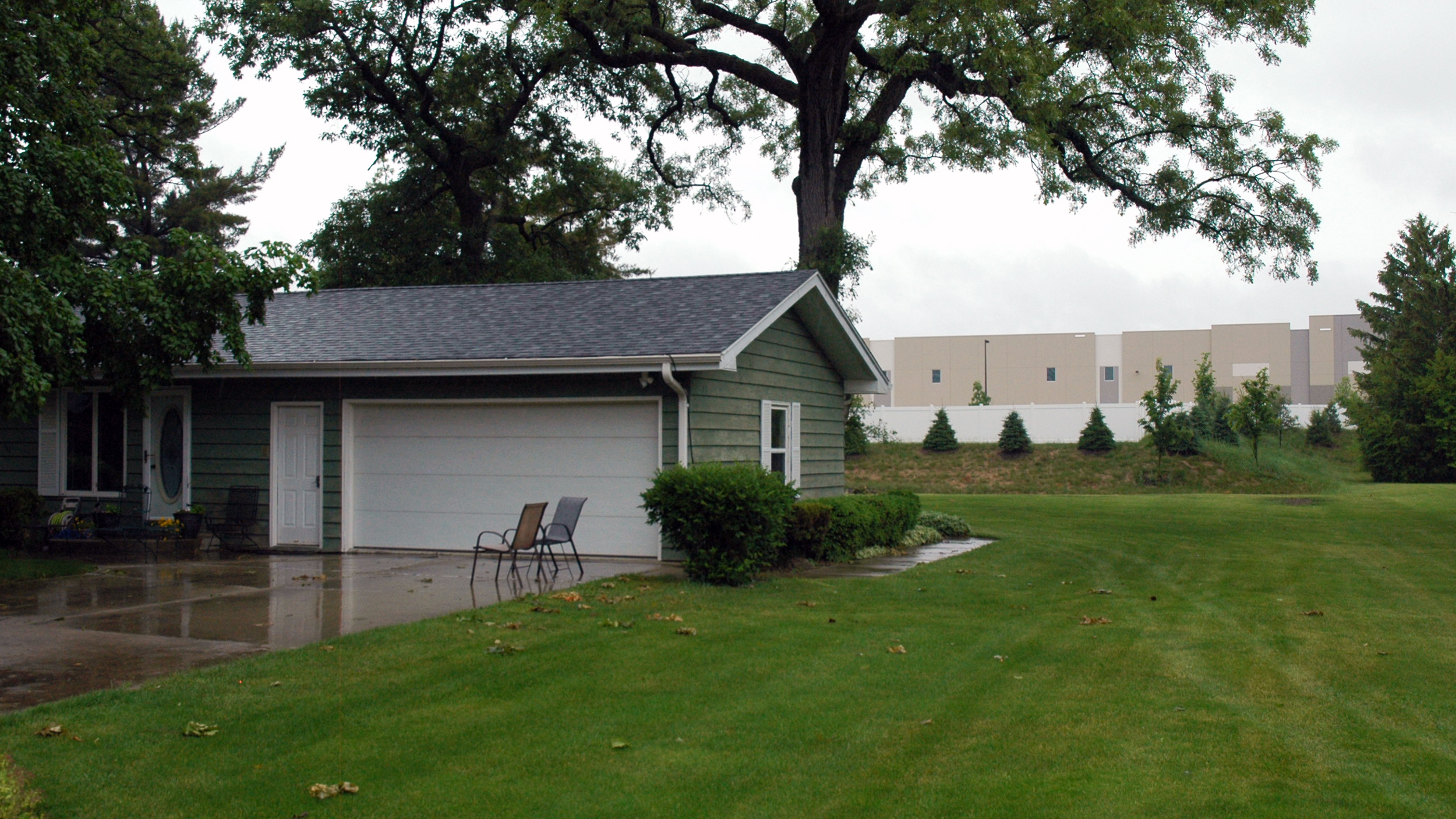
TNT production halted in 1976. After the federal government declared the complex inactive in 1993, part of it became the Abraham Lincoln National Cemetery, part was converted into Midewin National Tallgrass Prairie and the rest became CenterPoint, to take advantage of the existing rail and highway infrastructure.
The NorthPoint project reaches further east into a rural area of Will County that has limited highway access and no direct rail access.
On a gray, overcast day in early June, John Kieken and his brother-in-law, former Manhattan Village Trustee Ronald Adamski, drove around the area to give a tour of where the warehouses are and will be. Both are founders of Stop NorthPoint.
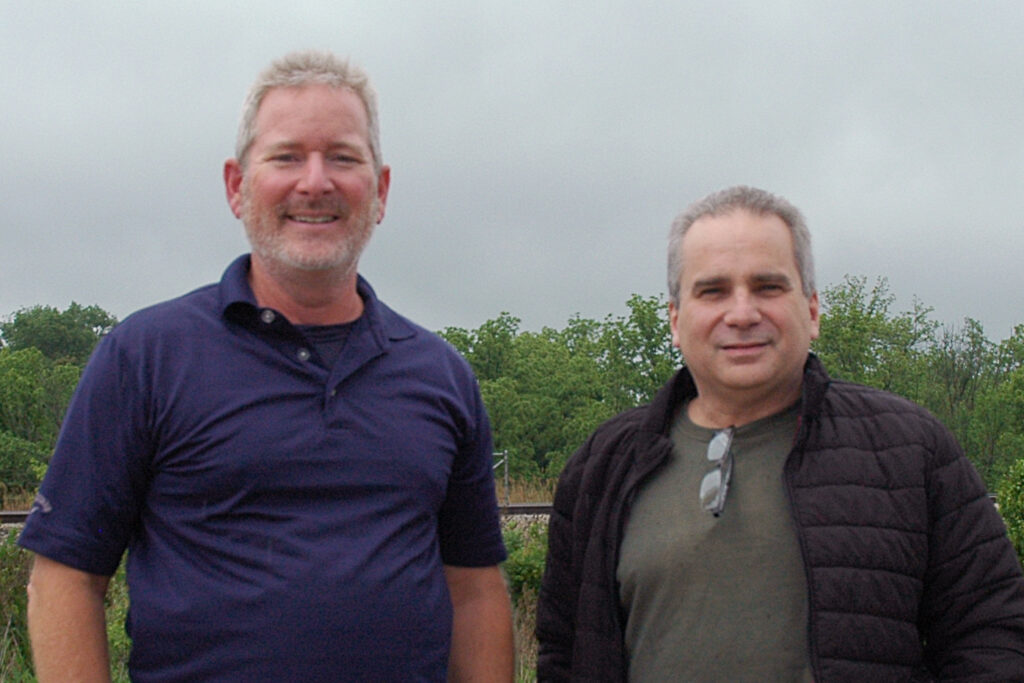
Kieken, riding in the back seat of Adamski’s GMC van, gestured to the right side of Cherry Hill Road, where Midewin National Tallgrass Prairie stretched eastward. It’s one of the few places in the state where bison herds roam; they were returned to the area in 2015, 178 years after the last bison was spotted in the area.
Under NorthPoint’s plans, warehouses would rise on the other side of the road about half a mile north of the park.
“North Point comes along and they’re proposing a project that’s going to [almost] double the size of the inland port. And we’re like, ‘Do we need to double the size of the inland port?’” Kieken said.
Together, CenterPoint and NorthPoint would stretch across an area more than twice the size of the village of Manhattan. Other companies will inevitably seek to build yet more warehouses around the complexes, Kieken said, and he’s worried local officials aren’t planning for those impacts.
“We’re opposed to the incremental nature of it, filling in all the empty spaces and losing a lot more than what you were initially told,” he said.
The existing flow of trucks in the area has at times caused chaos. One carrying 35,000 pounds of plastic overturned on Interstate 55 in the county in April. Others have run off the road, including over three veterans’ graves in the Abraham Lincoln National Cemetery. And in October, the driver of another truck killed a 13-year-old boy on a bike in the village of Manhattan.

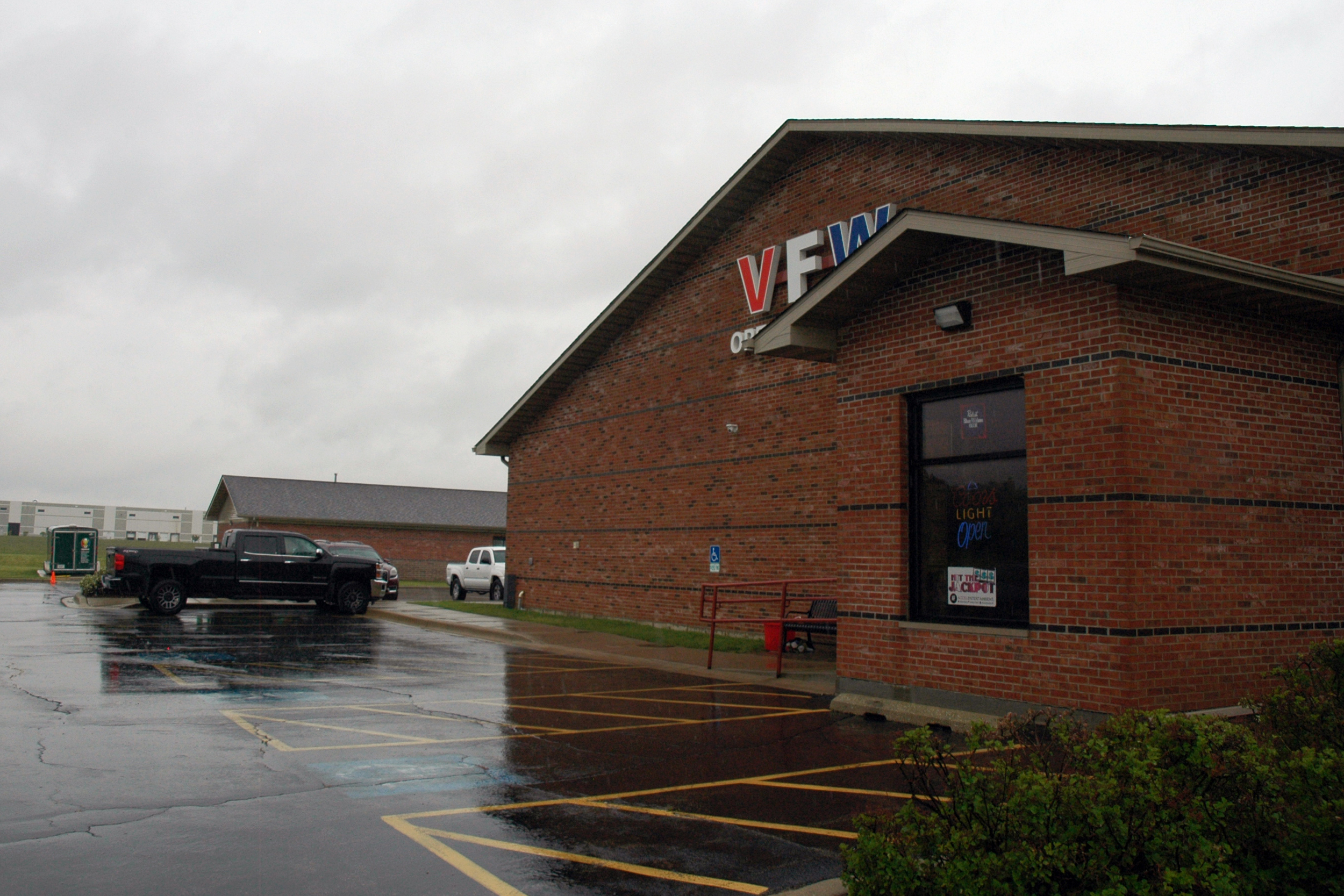
Kieken said that truck congestion has gotten so bad that he often sees semi-trucks on two-lane roads.
In June, the city of Joliet struck a deal with NorthPoint to require that trucks heading to and from there use a specially constructed Closed Loop Truck Network in an effort to keep them off local roads.
As Adamski drove closer to CenterPoint, the intermodal complex, the unmistakable kerosene-pungent smell of diesel seeped into the vehicle. It was 3 p.m., and for a few miles on Laraway Road, a seemingly endless line of semi-trucks blocked traffic. The massive trucks were either dropping off items to be moved out by train or picking up what the trains brought in.
Kieken, in the back seat, is an electrical engineer who earlier pored over the NorthPoint-commissioned traffic study that said the new development would bring 1,300 more trucks per day to the area. He thinks the actual number will be 10 times higher.
The Health Impacts of “a Constant Stream of Semis”
Laraway School in Joliet, which serves students in kindergarten through eighth grade, sat on Laraway Road for decades. But CenterPoint truck traffic became so heavy that it interfered with dropoff and pickup. And every day, the students and staff were breathing in harmful diesel pollutants.
“It was just a constant stream of semis,” said Ann Baskerville, an organizer with the Sierra Club Illinois Chapter.
In 2016, residents approved a referendum to move the school. Even in its new location, though, warehouses aren’t far off.
The air pollutants in diesel exhaust have been linked to diseases as wide-ranging as infant mortality, diabetes, lung cancer and dementia, in part because exposure can trigger inflammation and other problems that have cascading effects.
“Diesel emissions are important to study and control—they’re some of the most toxic of motor vehicle emissions,” said Dr. John Balmes, professor emeritus at the University of California San Francisco and UC Berkeley and physician member of the California Air Resources Board. “That’s why we’re trying to get rid of them in California.”

Balmes, who has researched air pollution for more than four decades, said the exposure is a problem for residents generally and in particular for the workers who come into the closest contact with the pollution. If the rest of the country adopted California’s standards for reducing diesel pollution, he said, it would extend lives.
The Sierra Club’s Baskerville monitored the air quality along Laraway Road one afternoon in 2018 as part of a citizen science project aimed at gauging how much pollution diesel trucks were spewing into the air. That main artery for truck traffic—the former location of Laraway School—was an obvious place to check.
“It’s just a huge impact,” she said. Reflecting on CenterPoint, she added: “It’s pretty striking, … just the amount of fossil fuels it takes to make that whole system go.”
Dany Robles, legislative director at the Illinois Environmental Council, notes that tailpipes also pose a climate risk. Transportation is a growing source of greenhouse gases in the state, he said, and shifts in both warehousing and retail, including e-commerce, are fueling the increase.
This story is funded by readers like you.
Our nonprofit newsroom provides award-winning climate coverage free of charge and advertising. We rely on donations from readers like you to keep going. Please donate now to support our work.
Donate NowRobles said that as consumer habits, like online shopping, have changed so has logistics. The emergence of even more warehousing as a way to accommodate the growth of e-commerce, comes with its own pollution and climate issues.
Zero-emission vehicles would change the calculus, both for air quality and the climate.
“One thing that, you know, we’re trying to do in California is have the electrification of trucks, both long-haul trucks and the shorter-haul trucks that carry from the warehouse to a big box store,” Balmes said. “We don’t expect a warehouse company to suddenly be able to electrify all their trucks, but we can put in for their permitting that they have to start getting a percentage of electric vehicles [in the fleet].”
Several local and national environmental organizations are pressing for Illinois to enact statewide regulations on warehouse pollution. Sam Becker from the Environmental Defense Fund said he’s been studying how other agencies, like California’s South Coast Air Quality Management District, approach the matter. He’s working with partners from local groups in Illinois to draft legislation.
“Right now, there’s no sort of substantial environmental review process for these truck-attracting facilities, like warehouses,” Becker said. “That means that these facilities can be sited without considering the impact that the warehouses, the trucks coming to and from them, the other polluting sources on site, are going to have on nearby communities.”
The proposal is still being refined. But options he sees to reduce warehouse impacts include installing solar panels and filtration systems for nearby schools and hospitals, requiring warehouses to phase in electric vehicles and mandating a public review process for new warehouses that would include an environmental review.
“We really need to do something about it,” Becker said.
Papesh, after years of tests from allergists locally and in Chicago, finally found a regimen that works to reduce her asthma symptoms. Even travel to specialists, though, has posed problems.
“We were on our way to Chicago for a vocal cord dysfunction test at University of Chicago, and I ended up behind a semi-truck that was giving out tons of exhaust. You know how sometimes it’s just overwhelming? Well, we get up to the hospital and I told my husband, I said, ‘Forget the vocal cord dysfunction test. We’re going to the emergency room. I cannot breathe,’” said Papesh.
It’s why she doesn’t want many more of them heading to her community. Diesel isn’t good for anyone’s lungs, but she experiences the impact right away.
“I sometimes feel like the canary in the coal mines, you know?” she said.
About This Story
Perhaps you noticed: This story, like all the news we publish, is free to read. That’s because Inside Climate News is a 501c3 nonprofit organization. We do not charge a subscription fee, lock our news behind a paywall, or clutter our website with ads. We make our news on climate and the environment freely available to you and anyone who wants it.
That’s not all. We also share our news for free with scores of other media organizations around the country. Many of them can’t afford to do environmental journalism of their own. We’ve built bureaus from coast to coast to report local stories, collaborate with local newsrooms and co-publish articles so that this vital work is shared as widely as possible.
Two of us launched ICN in 2007. Six years later we earned a Pulitzer Prize for National Reporting, and now we run the oldest and largest dedicated climate newsroom in the nation. We tell the story in all its complexity. We hold polluters accountable. We expose environmental injustice. We debunk misinformation. We scrutinize solutions and inspire action.
Donations from readers like you fund every aspect of what we do. If you don’t already, will you support our ongoing work, our reporting on the biggest crisis facing our planet, and help us reach even more readers in more places?
Please take a moment to make a tax-deductible donation. Every one of them makes a difference.
Thank you,

